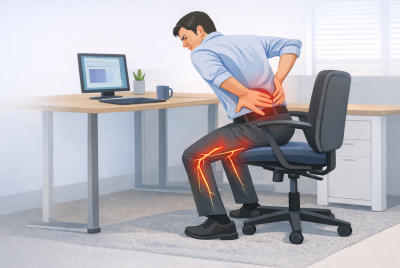Running With Sciatica
Discover the art of running with sciatica – expert tips, footwear advice, nutrition insights, and personal insights for a pain-free run. Dive into our guide now! Embarking on the journey of running with sciatica requires not only enthusiasm but also a comprehensive understanding of how to navigate the challenges that come with this condition. As an avid runner and someone who has dealt with sciatica, I am eager to share insights and practical suggestions to help fellow enthusiasts make the most of their running experience while managing sciatic pain.
Understanding Sciatica
Sciatica, characterized by pain radiating along the sciatic nerve, can be a formidable hurdle for runners. Having personally navigated the complexities of sciatica, I’ve come to appreciate the importance of gaining a deep understanding of this condition. Beyond its symptoms, understanding the root causes and triggers becomes crucial for anyone looking to continue their running routine.
Impact of Sciatica on Running
The impact of sciatica on running extends beyond mere discomfort; it can significantly hinder performance and undermine the joy of the activity. Recognizing the nuanced signals your body sends during a run becomes paramount, allowing you to make informed decisions that promote both enjoyment and safety.
Risks and Considerations
Before embarking on a run with sciatica, it’s imperative to acknowledge and carefully consider the associated risks. Consulting with a healthcare professional is a crucial step in gaining a clear understanding of your individual circumstances and ensuring that your chosen running routine aligns with your overall health goals.
Importance of Proper Warm-Up
A robust warm-up routine emerges as a cornerstone in mitigating the impact of sciatica during running. Going beyond mere stretching, incorporating dynamic movements and exercises helps prepare muscles and joints adequately. This not only reduces the risk of exacerbating sciatic pain but also enhances overall performance.
Choosing the Right Footwear
Investing in the right pair of running shoes becomes a pivotal decision for individuals dealing with sciatica. Opt for shoes that not only provide adequate arch support but also offer sufficient cushioning to absorb impact. The right footwear can make a substantial difference in minimizing stress on the sciatic nerve during a run.
Ideal Running Surfaces
Considering the running surface is another critical aspect when managing sciatica. Opting for softer terrains such as trails or tracks can significantly reduce the impact on joints. Conversely, avoiding concrete or uneven surfaces helps prevent unnecessary strain that may worsen sciatic discomfort.
Incorporating Low-Impact Exercises
Balancing high-impact running with low-impact exercises is a strategic approach. Activities like swimming or cycling can help maintain cardiovascular fitness without subjecting the sciatic nerve to excessive stress. Finding this balance ensures a holistic approach to fitness without compromising on running goals.

Strengthening Core Muscles
Building a resilient core stands out as a proactive measure against sciatica-related discomfort. Targeted exercises that strengthen core muscles contribute to overall stability, reducing the likelihood of aggravating the condition during runs. A strong core becomes a protective shield against the impact of running on the sciatic nerve.
Effective Stretching Techniques
While the importance of stretching has been emphasized, delving deeper into effective stretching techniques is paramount. Focus on specific stretches that promote flexibility in the lower back, hamstrings, and glutes. Consistency in these stretches not only alleviates tension but also contributes to an overall more comfortable running experience.
Listening to Your Body
The art of listening to your body takes on heightened significance when running with sciatica. Tuning into signals of pain or discomfort and responding promptly by adjusting running intensity or taking breaks is essential. This self-awareness forms the foundation of a sustainable and enjoyable running routine.
Seeking Professional Guidance
Beyond personal awareness, seeking professional guidance is a non-negotiable step for individuals managing sciatica. Healthcare professionals or physiotherapists can offer tailored advice, prescribe specific exercises, and provide ongoing support to ensure a safe and effective approach to running with sciatica.
Testimonials and Success Stories
Exploring the journeys of others who have successfully managed sciatica while continuing to run can be a wellspring of motivation. Personal anecdotes and success stories offer insights into diverse strategies, allowing individuals to glean wisdom and inspiration from those who have faced similar challenges.
Nutrition Tips for Sciatica and Running
Optimizing nutrition is crucial for managing sciatica while running. Prioritize an anti-inflammatory diet by incorporating foods rich in omega-3 fatty acids, antioxidants, and essential vitamins. Hydration is equally vital, supporting muscle and joint health. Ensure a balanced intake of nutrients to promote overall well-being. Consult a nutritionist for personalized advice tailored to your specific needs and running routine. Integrating foods like fatty fish, leafy greens, and nuts can help reduce inflammation and provide the necessary nutrients for optimal nerve health. Hydrate adequately to maintain joint lubrication and prevent stiffness. Consistent adherence to a well-rounded nutrition plan complements your running endeavors, contributing to a holistic approach to managing sciatica and fostering overall health.
Frequently Asked Questions (FAQs)
Can running worsen sciatica symptoms?
Running has the potential to worsen sciatica symptoms. The repetitive impact on joints and the spine may exacerbate discomfort. It is crucial to recognize individual limits and seek professional advice. Consulting with a healthcare professional ensures a tailored approach, minimizing the risk of aggravating sciatic pain and promoting a safer running experience.
How often should I stretch before a run with sciatica?
Stretch before each run with sciatica for at least 15-20 minutes. Regular stretching enhances flexibility, reducing strain on the sciatic nerve. Incorporating dynamic stretches into your routine warms up muscles and prepares them for the impact of running. Prioritize this proactive measure to minimize the risk of exacerbating sciatica symptoms and promote a more comfortable running experience.
Are there specific shoes for runners with sciatica?
Runners with sciatica should consult a podiatrist to find shoes tailored to their needs. Opt for footwear with optimal arch support and cushioning to absorb impact, reducing stress on the sciatic nerve. Choosing the right shoes is crucial for mitigating discomfort and ensuring a supportive foundation, enhancing overall comfort and safety during running with sciatica.
Can core strengthening exercises eliminate sciatica pain completely?
While not a guaranteed cure, consistent core strengthening exercises can significantly reduce sciatic pain. Strengthening the core muscles provides enhanced spinal support, reducing the likelihood of pain. Regular incorporation of targeted exercises contributes to overall stability and may lead to a substantial reduction in sciatica discomfort, improving the individual’s quality of life and mobility.
Is it advisable to run with sciatica without professional guidance?
Running with sciatica without professional guidance is not advisable. Seek advice from healthcare professionals who can provide personalized recommendations. Running without proper guidance may exacerbate symptoms and pose risks to your overall health. Professionals can offer insights into tailored exercise routines, ensuring a safe and effective approach that aligns with your unique condition and goals.
Running With Sciatica – Conclusion
In conclusion, running with sciatica demands a balanced and informed approach. By understanding the condition, recognizing individual limitations, and incorporating preventive measures, enthusiasts can navigate this challenging journey successfully. Listening to the body, choosing appropriate footwear, and seeking professional guidance are essential components. Consistent warm-ups, low-impact exercises, and a strong core contribute to a safer running experience. Nutrition plays a vital role, with an anti-inflammatory diet aiding in managing symptoms. Embracing testimonials and success stories fosters motivation. In essence, running with sciatica is not merely a physical activity but a holistic lifestyle requiring diligence, awareness, and a commitment to overall well-being.
Disclaimer
Please note that the information provided in this article is for informational purposes only and should not replace professional medical advice. If you’re experiencing sciatica pain or any health concerns, it’s advisable to consult a healthcare professional for proper diagnosis and treatment.






